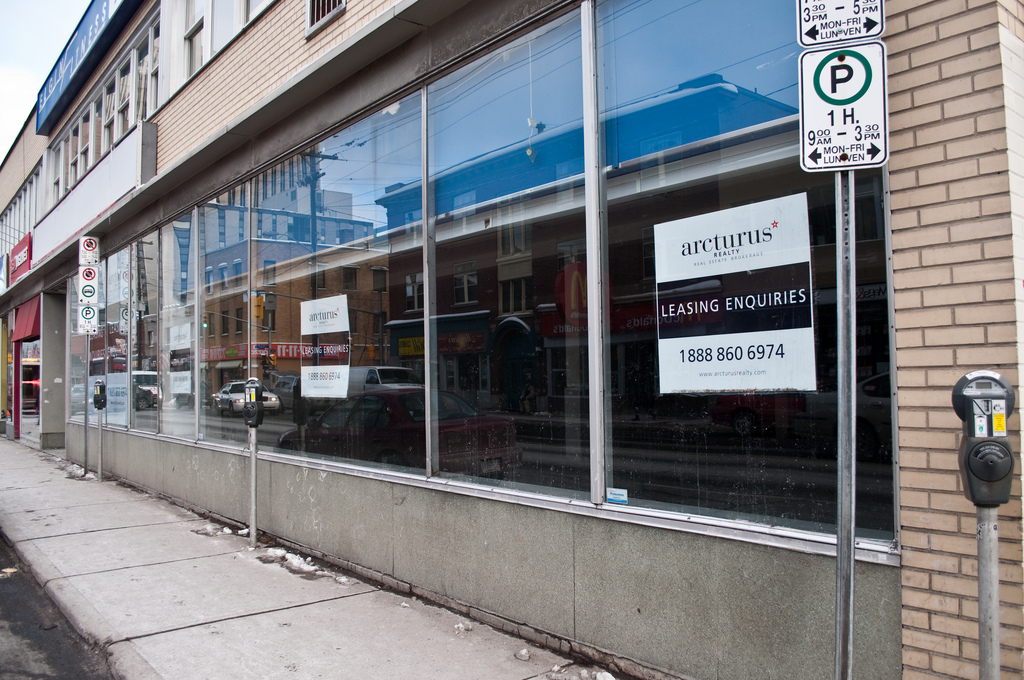
Last week the CBC and the radio program Q ran a most interesting story about the importance of space for the artist.
In the UK, an arts collective known as The Oubliette are “advocating turning unused commercial and industrial property over to arts groups as a way of advancing the arts economy.” They have been drawing public attention to the artist’s need for space and the hundreds of spaces left vacant in London –some lying unused for 10-20 years. The group acts as a “middle-man” and argues “the lending of empty space can be seen as an alternative way to fund the arts, without either private or public financing.”
Now, back to this Nation’s Capital . . . just think of all of the vacant spaces in Ottawa.
A few weeks ago, Spacing Ottawa posted a piece about the Ogilvy Building, abandoned 17 years and counting. I bet you can think of at least one vacant space in your neighbourhood right now. Maybe it’s a warehouse or a church or an office space. For me, I shake my head every time I walk by the void that was Goldstein’s Grocery on Elgin Street, nearly 4 years vacant, and sigh over the lost potential.
Good affordable space is at a premium for artists in this city, especially for emerging or amateur groups that cannot afford the costly professional facilities already backlogged with rental requests. The Oubliette is on to something.
Let me be clear. I am not advocating the radical takeover or bureaucratic brokering of public space. Nor am I saying that empty urban space in Ottawa should be used for artistic productions. (While this is something The Oubliette does in London, having worked in the arts for many years, I know how complicated production issues can get –especially with wary property owners and a particularly prickly City Council in the mix.)
What I am throwing out there is the grassroots idea that Ottawa property owners should consider temporarily lending vacant space to artists for what I will call “gentle use” (readings, practices, rehearsals, group meetings, talks, lectures, etc.).
It should be an attractive swap for owners. They loan something useful to the local arts community, like space, and rather than worrying about vandalism, fire hazards, and property upkeep notices from the city, they get gentle-use “tenants” who showcase the potential of the property while creating art — and community goodwill toward the owner.
So how can property owners collaborate with artists?
1. Community outreach. Space can be advertised through community groups, listservs, websites . . . all for free.
2. Facilitate a key exchange and review security rules and insurance liability.
3. Ask for a reasonable damage deposit. (Cause damage, forfeit the deposit.) Otherwise, rent is free.
Ottawa’s creative culture is suffering because studio and practice space is out of reach for so many working artists. Yet the arts are a big part of what makes some cities more attractive than others for newcomers and major employers. A community that can find ways to invest in its artists is investing in itself.
Photo credit: Jeremie Deschenes

5 comments
Love this idea – as a photographer in Hintonburg how great would it be if ANY of the storefronts along Wellington be leased for a community gallery at a nominal cost. Heck – we’d probably even provide the paint and gladly move along when a tenant came in, since art spaces usually change up monthly at the latest…
Great article Kate. Really made me think about what I could use such a space for. I came up with more than a few ideas.
Cheers
The city (and possibly even the province) would have to pitch in. Part of the reason owners of vacant space are hesitant to do this is that there are tax consequences to using it.. both on any income and on the property taxes.
It could be a cheap (for all involved) way to get some public art space in the city. Good article.
Great concept. As another commenter noted, there are likely savings from having the building vacant– insurance for one, as well as previously mentionned taxes. With regards to taxes, in a perfect world the city would see two options: no taxes and a vacant building, or no taxes (through tax breaks, etc, for this cause) and improving the city’s culture, and would exploit this opportunity (for once, exploiting a non-monetary gain).
If the monetary gains of having real estate empty are low, then property owners could themselves gain by having users, as another commenter suggested, improve the space through, for example, painting.
The city would do well to create some form of program or department that provides the medium for discussions between property owners and the community. While a property owner might be sceptical of an artist knocking on their door, interacting through the City of Ottawa would provide legitimacy, as well as likely reduce liability issues.
This is a great idea! Let me know if you organize and need a Planner to pitch in.